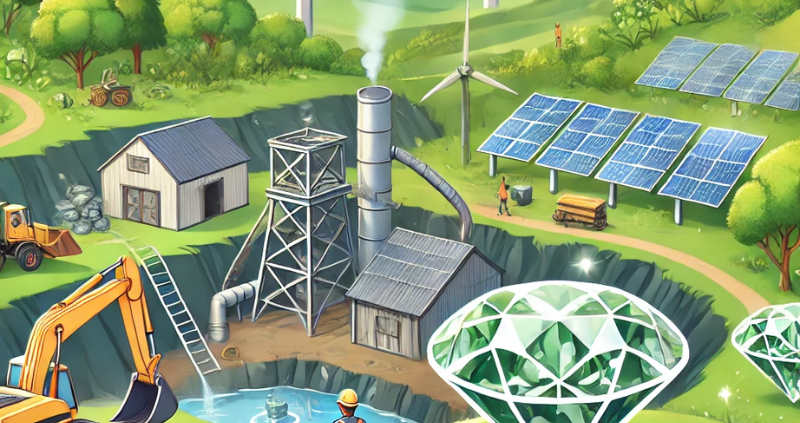Sustainability in the Diamond Industry: Challenges and Opportunities

The diamond industry, long revered for producing one of the world’s most desired gemstones, faces increasing scrutiny for its environmental and social impacts. In today’s world, sustainability is not just a buzzword but a fundamental requirement for industries that wish to thrive. For the diamond industry, the path to sustainability is filled with both challenges and opportunities.
What Are the Challenges Faced by the Diamond Industry?
The diamond industry faces several critical challenges in becoming more sustainable. One of the foremost issues is the environmental degradation caused by mining operations. Traditional diamond mining can lead to deforestation, the disruption of ecosystems, and the depletion of water resources. Additionally, the energy-intensive nature of mining contributes significantly to carbon emissions.
Another major challenge is ethical sourcing. Consumers are increasingly concerned about the origins of the diamonds they purchase. The fear of purchasing so-called “blood diamonds,” which are mined in conflict zones and used to finance wars, has led to a demand for transparency in the supply chain. Implementing and maintaining systems that ensure diamonds are ethically sourced requires significant investment in technology and compliance.
The economic inequality in diamond-producing regions presents another hurdle. Many diamond mines are located in developing countries where local communities often do not benefit fairly from the wealth generated. Poor working conditions, child labour, and exploitation are still prevalent in certain regions, tarnishing the reputation of the industry as a whole.
How Can the Diamond Industry Be Sustainable?
Sustainability in the diamond industry can be achieved through a combination of technological advancements, ethical practices, and environmental supervision. One of the most promising developments is the rise of lab-grown diamonds. These diamonds are created using advanced technologies that mimic the natural process of diamond formation but without the environmental toll. Lab-grown diamonds offer the same quality and characteristics as mined diamonds and are often less expensive.
Another path to sustainability is the adoption of responsible mining practices. Several diamond companies have started employing methods that reduce environmental impact, such as using renewable energy sources for mining operations, minimising waste, and restoring ecosystems post-mining. Certifications like the Kimberley Process and the Responsible Jewellery Council (RJC) help ensure that diamonds are sourced ethically and responsibly.
Supply chain transparency is also crucial. Blockchain technology is increasingly being used to trace the journey of diamonds from the mine to the market. This innovation allows consumers to verify that the diamonds they purchase are ethically sourced and conflict-free, thus promoting more responsible consumption.
What Are the Environmental Impacts of the Diamond Industry?
The diamond industry has a significant environmental footprint. Traditional diamond mining requires the removal of large quantities of earth, often leading to habitat destruction and deforestation. Mining can also contaminate nearby water sources with chemicals, leading to water pollution and adversely affecting local ecosystems.
Lab-grown diamonds, on the other hand, though touted as a sustainable alternative, also have an environmental impact. The production process requires a large amount of energy, often from non-renewable sources, though it is still significantly less than the impact of traditional mining. If lab-grown diamond producers transition to renewable energy, the environmental benefits could be even more pronounced.
What Are Two Negative Aspects of the Diamond Industry?
Two significant negative aspects of the diamond industry are environmental degradation and social exploitation. As mentioned earlier, diamond mining often results in severe environmental damage, including deforestation, loss of biodiversity, and water contamination. The scale of land disrupted for mining is immense, leaving scars on the landscape and affecting the wildlife and communities that depend on the surrounding environment.
Secondly, is the social cost. In many diamond-producing regions, the wealth generated by diamond sales does not trickle down to local communities. Instead, workers often face harsh conditions, low wages, and a lack of basic rights. Although initiatives like the Kimberley Process have reduced the circulation of conflict diamonds, challenges remain in ensuring that all diamonds are sourced ethically.
Opportunities for a Sustainable Future
Despite these challenges, the diamond industry is uniquely positioned to take advantage of sustainability opportunities. The demand for ethical and eco-friendly products is growing, and the industry can meet this demand by continuing to develop lab-grown diamonds, improving mining practices, and increasing transparency in the supply chain.
Companies that prioritise corporate social responsibility (CSR) and work to benefit local communities can set themselves apart from competitors. This includes fair wages, safer working conditions, and investments in community development projects. Additionally, diamond companies can contribute to global environmental goals by offsetting their carbon footprints and investing in renewable energy.
The rise of digital technologies also presents an opportunity for the industry. Blockchain technology, for instance, allows for greater transparency and trust in the diamond supply chain. By giving consumers access to detailed information about their diamond’s journey from mine to market, companies can enhance trust and drive sustainable growth.
In conclusion, while the diamond industry faces significant sustainability challenges, it also has the tools and opportunities to transform itself. Through innovation, ethical practices, and environmental responsibility, the industry can ensure its future while contributing positively to the planet and society. The future of diamonds can indeed be sustainable, if the right steps are taken today.

